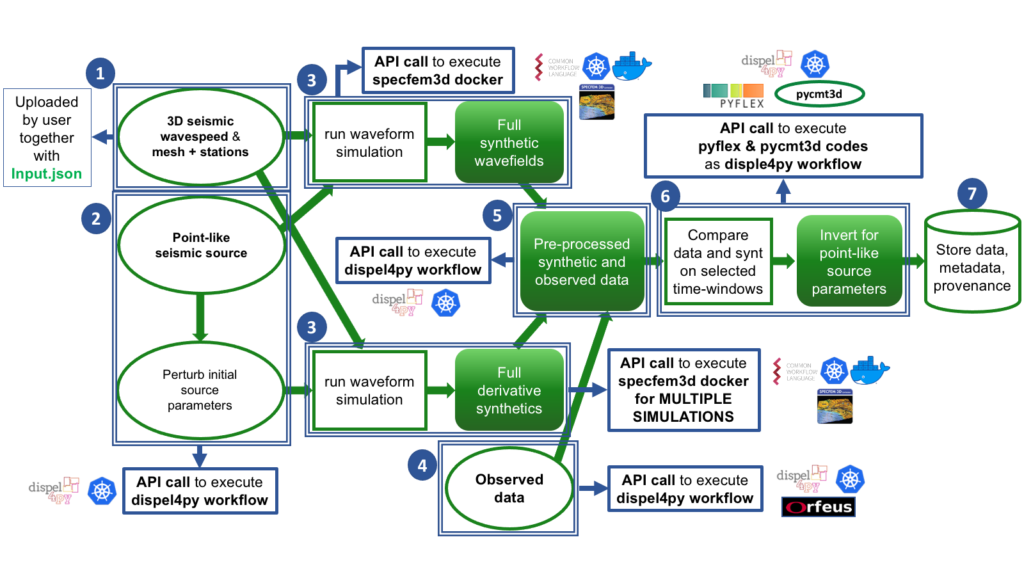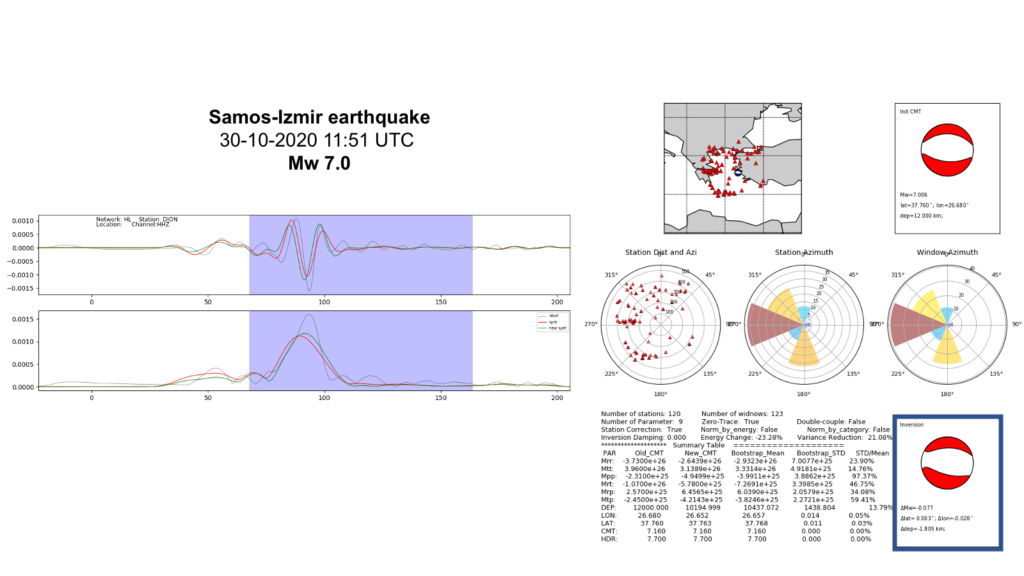EPOS | MT3D – Moment Tensor in 3D
The Moment Tensor in 3D (MT3D) test case, implemented in the DARE platform in the framework of the EPOS Use Case, focuses on the characterization of the earthquake source parameters and their uncertainties to study the impact on wave propagation and hazard assessment.
The implemented procedure starts from an initial solution representing a point-like earthquake source, usually routinely calculated by seismic communities using 1D wavespeed models. The main parameters of a point source are the location and the moment tensor, which describes the magnitude and mechanism of the earthquake rupture. The scope is to refine the initial solution by using source inversion procedures that take into account more reliable 3D seismic wavespeed models and find a new best solution that minimizes the misfit between observed and synthetic wavefields.
The adopted technique requires multiple waveform simulations: 1 for the initial synthetic wavefield and up to 9 for synthetic seismic wavefields based on perturbed source parameters.
The seismology community tackles daily similar inverse problems applied to seismic source and it will greatly benefit from the possibility of executing automate, reusable and customisable workflows, such as MT3D, implemented in the DARE platform. This kind of workflow can be also included as a routine procedure to calculate 3D moment tensor solutions for the earthquakes in monitoring centres presently using simple 1D wavespeed models.
Figure 3 below shows the detailed steps of the MT3D workflow and how they are implemented and executed in the DARE platform:
- Users set the input parameters in the file Input.json, and prepare the input files for the simulation code SPECFEM3D_Cartesian [Peter et al. 2011]: Par_file, list of seismic stations, 3D wavespeed model, and a mesh. Users upload all these files in the DARE shared file system.
- An initial model for a point-like seismic source is constructed. Then the initial source parameters are perturbed to obtain the perturbed input source models. This step is implemented as a dispel4py workflow and executed in the platform via a corresponding API call.
- With inputs in 1. and 2., waveform simulations are run with the code SPECFEM3D_Cartesian to obtain both the initial and the perturbed (called derivative) synthetic seismograms (up to 10 simulations). In DARE the dockerized version of SPECFEM3D is used and the specific steps to run a simulation are described by a CWL workflow launched via an appropriate API call.
- Raw observed seismograms for the chosen earthquake are downloaded, e.g., from public European archives, such as EIDA. This step is implemented as a dispel4py workflow and executed in the platform via a corresponding API call.
- All the synthetic seismograms in 3. (both initial and derivative) and observed data in 4. are pre-processed in the same way (e.g., filtering the traces) to assure their consistency and prepare them for the following analyses. This step is implemented as a dispel4py workflow and executed in the platform via a corresponding API call.
- Observed data and synthetics are compared and suitable time windows for the source inversion are selected using the python code pyflex. Then new source parameters (moment tensor and location), which minimize the misfit between data and synthetics, are calculated through the inversion procedure using the python code pycmt3d. A unique dispel4py workflow describes these last two steps and is executed in the platform via a corresponding API call.
- Output products are stored with their metadata and provenance.
Metadata and provenance are captured and stored for all the workflows through dispel4py and CWL, and they are fully customisable and explorable through the Provenance Viewer Portal.

Figure 3: Implementation of the MT3D test case in the DARE platform
Figure 4 shows the typical output files that can be obtained for the MT3D test case.
The example in Figure 4 is for a recent, large earthquake occurred next to the Greek island of Samos and the Turkish city of Izmir on 30 October 2020 with Mw 7, which caused many damages and deaths also associated to the generated tsunami.
Thanks to the implementation of the MT3D test case in the DARE platform, we could start from the source solution obtained right after the earthquake with a simple 1D velocity model and easily refine it using a more reliable 3D model of the region. The new solution corresponds to synthetic seismograms closer to the records and represents an improved characterization of the source parameters.
This is an operational application of the DARE platform to solve a typical inverse problem in seismology and provide information on the earthquake source useful for seismic hazard assessment in the emergency context.

Figure 4: Example of output from the execution of the MT3D test case. The figure on the left is, for a given seismic station, the comparison of observed seismogram (black), initial synthetic (red) and synthetic for the new source solution (green). In the figure on the right, the top right rectangle indicates the initial source solution with corresponding parameters; the bottom right rectangle is the new source solution from the inversion.
Material:
– Tutorial video: http://project-dare.eu/2020/12/11/dare-participated-eosc-expo2020/
– Jupyter Notebook for MT3D test case: https://gitlab.com/project-dare/dare-examples/-/blob/master/wp6/WP6_MT3D.ipynb
– Tutorial Jupyter Notebook for MT3D test case: https://gitlab.com/project-dare/dare-examples/-/blob/master/tutorial/WP6_MT3D_tutorial.ipynb
– dispel4py sub-workflows composing the test case: https://gitlab.com/project-dare/WP6_EPOS/-/tree/RA_total_script/processing_elements/MT-3D/workflow
– SPECFEM3D docker and CWL workflow
https://gitlab.com/project-dare/dare-platform/-/tree/master/containers/exec-context-specfem3d
https://gitlab.com/project-dare/dare-platform/-/tree/master/containers/specfem3d
https://gitlab.com/project-dare/WP6_EPOS/-/tree/RA_total_script/specfem3d/specfem3d_test_input_cwl
